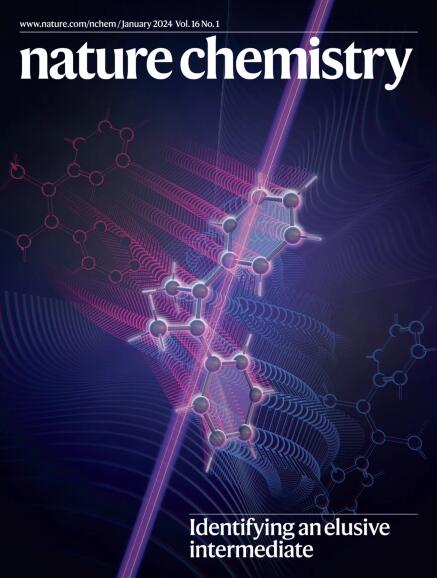非血红素铁依赖性酶的氮杂苷氨基酸生物合成。
IF 20.2
1区 化学
Q1 CHEMISTRY, MULTIDISCIPLINARY
引用次数: 0
摘要
氮杂环是一个四元氮杂环,是许多生物活性化合物和药物的重要结构。然而,它们的生物合成常常是神秘的。本文报道了氮杂啶氨基酸(多肟酸)生物合成在多毒素抗真菌途径中的作用机制。遗传、酶学和结构实验表明,PolF是血红加氧酶样二金属氧化酶和/或加氧酶(HDO)超家族的成员,该酶本身就足以通过3,4-去饱和中间体将l -异亮氨酸(L-Ile)和l -缬氨酸转化为它们的氮杂啶衍生物。对PolF的机理研究表明,μ-过氧化物- fe (III)2中间体直接导致了未活化的C-H键断裂,而h萃取后的反应,包括C-N键的形成,可能是通过自由基机制进行的。我们还发现,作为DUF6421家族的一员,PolE是一种铁和蝶呤依赖的氧化酶,它可以催化L-Ile的去饱和,通过增加L-Ile的去饱和通量来辅助PolF。这些结果为氮杂胞苷的生物合成和HDO酶的催化机制提供了重要的见解。本文章由计算机程序翻译,如有差异,请以英文原文为准。
Azetidine amino acid biosynthesis by non-haem iron-dependent enzymes.
Azetidine, a four-membered aza-cycle, is a crucial structure in many bioactive compounds and drugs. However, their biosynthesis is frequently enigmatic. Here we report the mechanism of azetidine amino acid (polyoximic acid) biosynthesis in the polyoxin antifungal pathway. Genetic, enzymological and structural experiments revealed that PolF is a member of haem-oxygenase-like dimetal oxidase and/or oxygenase (HDO) superfamily, and this enzyme alone is sufficient for the transformation of L-isoleucine (L-Ile) and L-valine to their azetidine derivatives via a 3,4-desaturated intermediate. Mechanistic studies of PolF suggested that a μ-peroxo-Fe(III)2 intermediate is directly responsible for the unactivated C-H bond cleavage, and the post-H-abstraction reactions, including the C-N bond formation, probably proceed through radical mechanisms. We also found that PolE, a member of the DUF6421 family, is an Fe and pterin-dependent oxidase that catalyses the desaturation of L-Ile, assisting PolF by increasing the flux of L-Ile desaturation. The results provide important insights into azetidine biosynthesis and the catalytic mechanisms of HDO enzymes in general.
求助全文
通过发布文献求助,成功后即可免费获取论文全文。
去求助
来源期刊

Nature chemistry
化学-化学综合
CiteScore
29.60
自引率
1.40%
发文量
226
审稿时长
1.7 months
期刊介绍:
Nature Chemistry is a monthly journal that publishes groundbreaking and significant research in all areas of chemistry. It covers traditional subjects such as analytical, inorganic, organic, and physical chemistry, as well as a wide range of other topics including catalysis, computational and theoretical chemistry, and environmental chemistry.
The journal also features interdisciplinary research at the interface of chemistry with biology, materials science, nanotechnology, and physics. Manuscripts detailing such multidisciplinary work are encouraged, as long as the central theme pertains to chemistry.
Aside from primary research, Nature Chemistry publishes review articles, news and views, research highlights from other journals, commentaries, book reviews, correspondence, and analysis of the broader chemical landscape. It also addresses crucial issues related to education, funding, policy, intellectual property, and the societal impact of chemistry.
Nature Chemistry is dedicated to ensuring the highest standards of original research through a fair and rigorous review process. It offers authors maximum visibility for their papers, access to a broad readership, exceptional copy editing and production standards, rapid publication, and independence from academic societies and other vested interests.
Overall, Nature Chemistry aims to be the authoritative voice of the global chemical community.
 求助内容:
求助内容: 应助结果提醒方式:
应助结果提醒方式:


